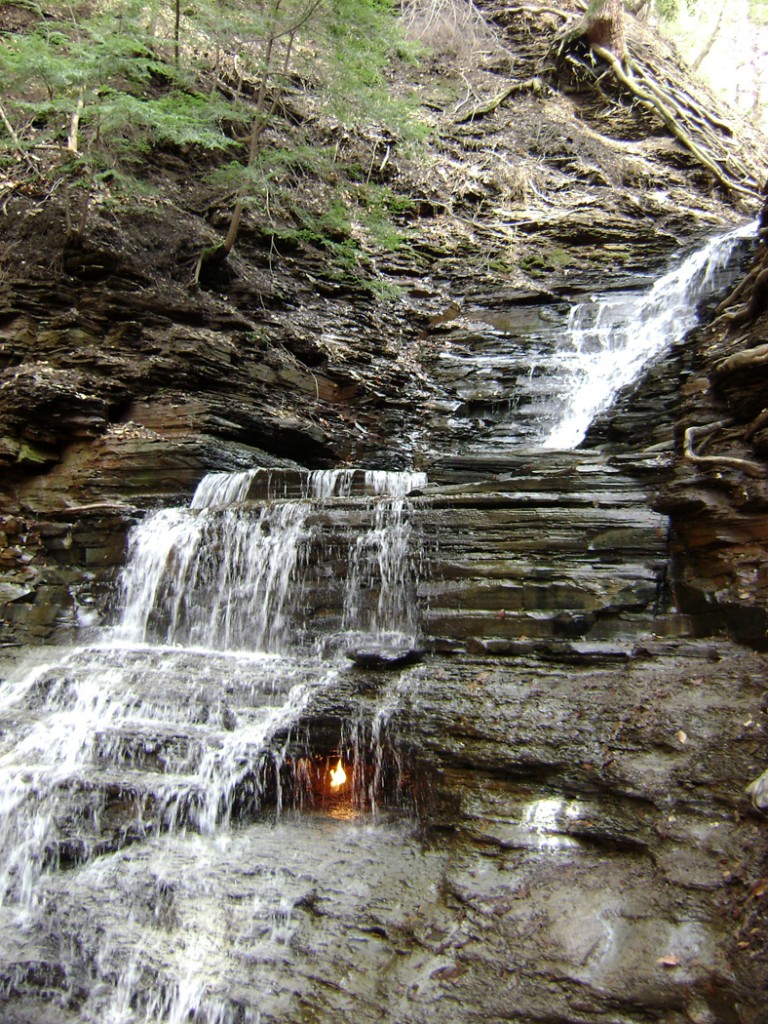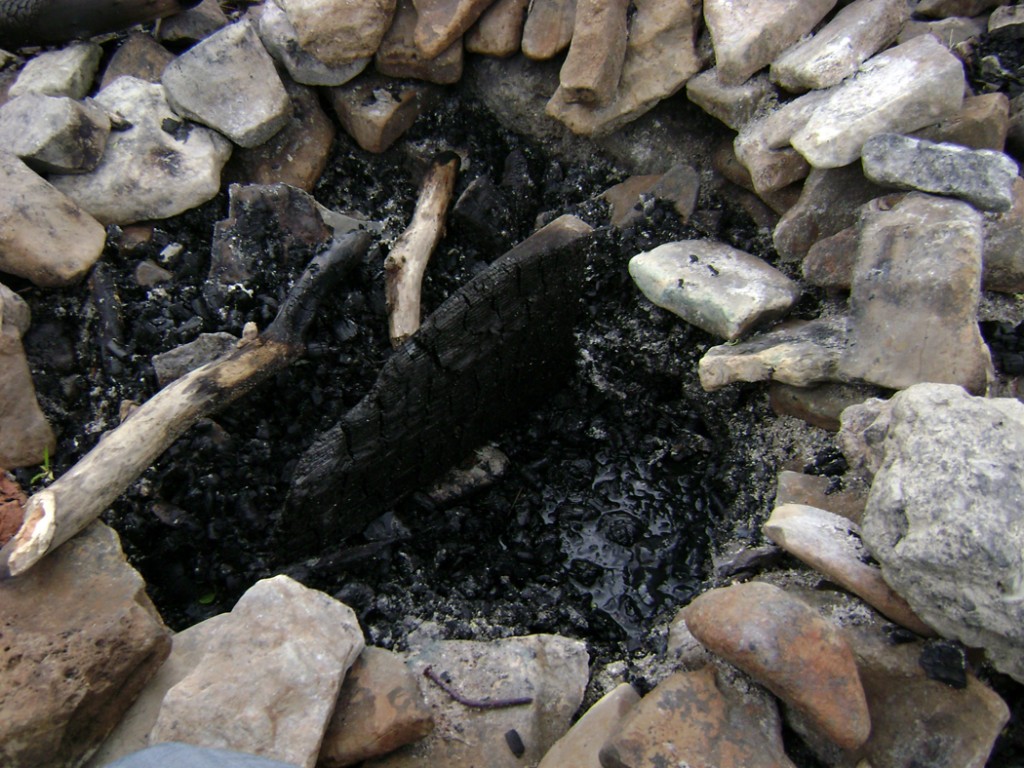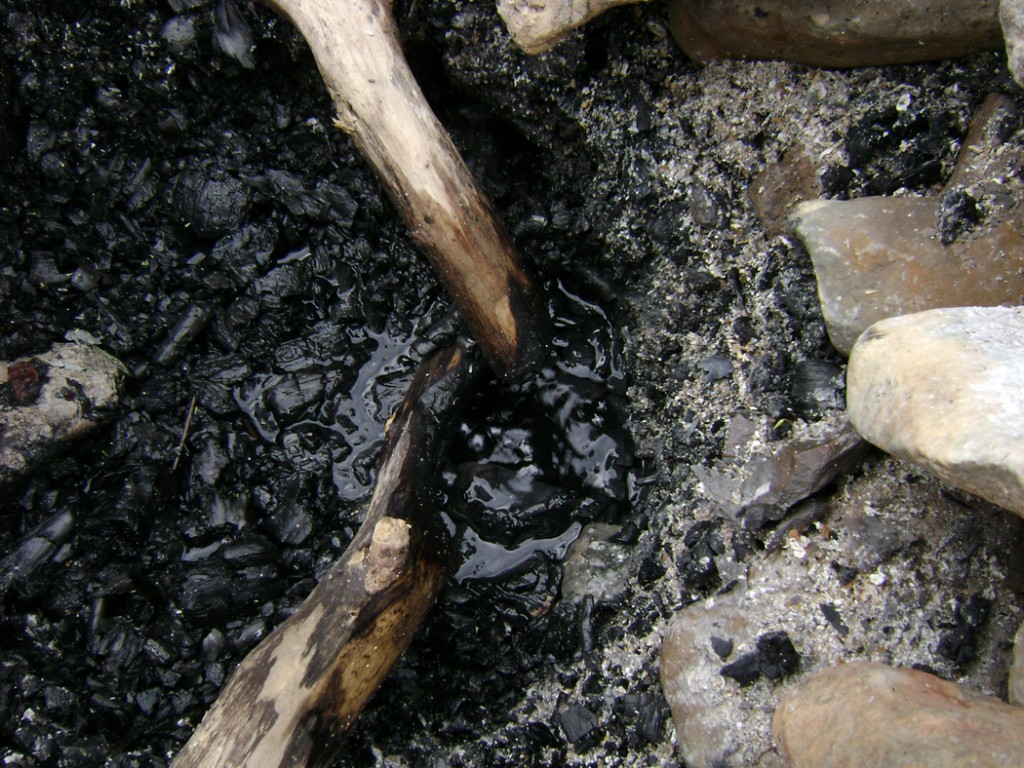12 November 2010
Natural gas seeps in Western NY
Posted by Jessica Ball
(My recent posts have been a bit on the negative side, so I’m going to step away from current events and work on finishing up some older ideas that I never managed to get to.)
One of the first things that everyone comments on when I tell them that I’m studying volcanology at Buffalo is the lack of volcanoes. Indeed, there is a serious lack of volcanoes, one that’s compounded by the fact that the area is underlain by sedimentary rock – not an igneous intrusion in sight. Still, there are some really neat things to see here (a waterfall comes to mind…) There’s a lot of green space in and around Buffalo (including a number of Olmstead parks), and in some of the parks I’ve visited are features that people commonly refer to as ‘eternal flames’. Unlike the ones you see at memorials in cemeteries, these are natural gas seeps that are lit on fire by geologists pyromaniacs curious observers.
One of my favorites is in the Shale Creek Preserve at Chestnut Ridge Park. See why?
That’s right – it’s under a waterfall! The flame is sheltered just enough that it doesn’t go out very often (although it’s always a good idea to bring a lighter along if you’re going to visit). Gas wells in this area are generally drilled into the Medina Group (a collection of sandsones and shales, which you can see exposed in the base of Niagara Falls to the north), but the seep itself is in the Hanover Shale, which apparently also has a bit of gas in it.
The whole base of the waterfall gets pretty gassy if the air isn’t moving much (it smells a bit like sulfur or rotten eggs), and I suspect that there are probably other seeps as well. (Sometimes you can see bubbling in the stream at the base of the falls.)
If you’re interested in Geocaching, this location is a great chance to snap up an Earthcache, too!
Another of my favorites is in Amherst State Park (and it’s not one that most people know about, since it takes a bit of walking and wading to get to. It’s also an interesting juxtaposition of fire and water, because it bubbles up through an island in the middle of a stream:
It appears to be a popular local hangout, although since it’s a bit more exposed, it’s not as “eternal” as the one at Chestnut Ridge – I don’t actually have a photo of the flame, because it was windy and too difficult to light that day. It seems to be a bit more productive, however, because the gas smell is much more pronounced. (I tend to keep my visits short if it’s not lit, for safety reasons.)
I’m pretty sure the unit making up the bedrock in the stream is the Akron Dolostone of the Salina Group, which includes shales (Camillus Shale). There are a number of natural gas wells in the Amherst area, however, and all of them are drilled into the Medina Group like those south of the city.
Natural gas drilling is a contentious subject in New York and Pennsylvania, mainly over concerns about the environmental impacts of hydraulic fracturing (where fluid is injected into an oil or gas well to stimulate the release of hydrocarbons in a “tight” rock unit). One of the professors here at UB has discovered that hydraulic fracturing could mobilize uranium from the Marcellus shale, the main hydrocarbon-producing unit in question – so it’s not as harmless as the natural gas industry would like it to be. At the moment, the New York State Senate has placed a hold on issuing gas drilling permits – essentially, a moratorium on Marcellus shale drilling – in order to assess the environmental impacts of allowing so much drilling. It wasn’t a particularly popular move, especially in a state with a $315 million budget deficit, but it’s a prudent one, since it’s given researchers time to study the effects of hydraulic fracturing.
So even though there isn’t any commercial drilling going on right now, with some effort you can still enjoy the benefits of straight-from-the-source hydrocarbon heating. (Just don’t get too close!)






 Jessica Ball is a volcanologist at the U.S. Geological Survey, researching volcanic hydrothermal systems and stability, and doing science communication for the California Volcano Observatory. She previously worked at the Geological Society of America's Washington DC Policy Office, learning about the intersection of Earth science and legislative affairs. Her Mendenhall postdoc and PhD focused on how water affects the stability of volcanoes, and involved both field investigations and numerical modeling applications. Her blogging covers a range of topics, from her experiences in academic geosciences to science outreach and communication to her field and lab work in volcanology.
Jessica Ball is a volcanologist at the U.S. Geological Survey, researching volcanic hydrothermal systems and stability, and doing science communication for the California Volcano Observatory. She previously worked at the Geological Society of America's Washington DC Policy Office, learning about the intersection of Earth science and legislative affairs. Her Mendenhall postdoc and PhD focused on how water affects the stability of volcanoes, and involved both field investigations and numerical modeling applications. Her blogging covers a range of topics, from her experiences in academic geosciences to science outreach and communication to her field and lab work in volcanology.
That flame under the waterfall is so cool!
I had never heard of this feature before I read this… then Bits and Pieces picked it up this morning, too. Looks like a different picture, so I don’t think it was swiped from you. Odd coincidence.
http://bitsandpieces.us/2010/11/13/eternal-flame-falls/
Nope, not swiped from here. I bet everyone who goes there takes a photo from the same spot, too. (It is interesting that it popped up recently, though.)
I grew up in Rochester and used to scramble all over similar features. If I’d known about the gas, I would’ve spent a lot more time sniffing for it.
Cool post – thanks!
As a former oil field hand, the key to the fracturing question is regulation and enforcement. The folks who run the oilfields are scofflaws of the first order by their nature, it is always good policy to keep a really good eye on them-even on the weekend, at night and over the holidays, times when they get up to their little cost savings tricks. A good cement job in a deep formation is pretty foolproof, producing off surface gas is nuts.
The thing that makes the Marcellus so attractive is that we have been drilling into it for years and have a very goof idea of how it breaks, what direction the crack is going to take. A directional bore at a 90 degree to the break and you have a Texas size well for cheap. Cheap-cheap-cheap. It is going to happen, we just have to keep a much better eye on the kids in the candy store.
Loved the seep pictures!
Interesting! We had an invited speaker recently talk about the Marcellus, but he didn’t give us the drillers’ perspective (more the regulation side of things).
Enforcement is what is lacking in the drilling industry, the problem is that the regulation people; writers of the rules and enforcers of the rules are captive of the drilling and production interests. There is real reason to worry about drilling in any area, the oilfield industry has no respect for the law, little or any fear of the law, they find ways to save money because nine times out of ten it goes right into the driller’s pocket. My experience was that there was little incentive to follow the rules. The sad part is that we know full well how to produce oil and gas in a safe manner, it just costs more.
There is a remote village in Nepal called Muktinath that has a Buddhist temple with earth, air, holy water and fire. The holy water ran next to the flame of a natural gas seep.
Was one of the most amazing places I’ve visited.
i also grew up in that area,in Minnesota now,and the gas seeps are something i never knew about.better late than never.
I lived in the Toronto area for a long time. The stratified rock in the escarpment running north from Niagara Falls is well known for gas seepage. There have been houses in the area south of Hamilton that blew up from the accumulated gas when the owners did not know (or forgot) to vent it in time. Nobody has tried to capture the gas until now.
Wow! that’s a really cool picture, and I appreciate your balanced assessment – a huge potential resource that should be safely tapped into.
Jim: surface gas is tricky to produce, too much chance of ruining the well water that people use for drinking.
Thank you for submitting this as your Accretionary Wedge -29 piece.
I thought you would want to know AW 29 – “What Geological features about the area you call ‘home’ do you love? and what do you not like?” is now posted at Ann’s Musings on Geology and Other Things.
http://annsmusingsongeologyotherthings.blogspot.com/2010/12/accretionary-wedge-29.html
[…] But while it might not be common, it does happen. Western New York state, for instance, is home to multiple “eternal flames,” spots where natural gas has escaped its geologic prison and made it to the […]